How to guide on Aquarium Filters?: Explore the vital role of aquarium filters in maintaining a healthy aquatic habitat with our expert guide. Discover why filters are indispensable for your aquarium, how they work to remove impurities, and the advantages and challenges they present. We’ll walk you through setting up your filter and compare various types, including canister, hang-on-back, and sponge filters, to help you make an informed choice for your tank. Whether you’re a beginner or an experienced aquarist, this guide offers essential insights to enhance your aquarium’s ecosystem efficiently.
Table of Contents
Why do we need an aquarium filter?
Any dead or decaying matter, food and fish waste in the aquarium will be converted to ammonia and ammonia is very harmful for the fish and any high levels of ammonia will kill the fish. The entire process takes place within a Aquarium filter.
How does a fish tank filter work?

Once your tank is fully cycled for 3 weeks, in the biological media in your filters you will have good bacteria’s which will help convert ammonia to nitrite (by Nitrosomonas) and then to nitrate (by Nitrospira). Nitrate are not harmful to the fish and they are generally absorbed by plants during photosynthesis. The entire process happens if you have good quality biological media in your filters.
Choosing the Right Aquarium Filter for Your Tank
Aquarium filters are a vital part of any aquarium setup. They keep the water in your tank clean and clear by removing excess fish waste, uneaten food, and other particulates.
They come in many shapes and sizes. The size of your tank will determine which type of filter you need to buy. For example, if you have a 10-gallon tank, you would need a smaller filter than if you had a 100-gallon tank.
The most important thing to consider when choosing an aquarium filter is the flow rate. The flow rate is measured in gallons per hour (GPH) or litres per hour (LPH). The higher the flow rate, the more powerful the filter will be at removing particles from your water column.
General rule of thumb is that flow rate is 5 * size or volume of water in your tank.
For e.g. you have a 200 liter tank then you would need approx. 200*5 = 1000 liter per hour flow so choose filter which can support it. Please do not go by factory recommendations given by manufactures as they don’t seem to be correct.
Why is Flow Rate so important?
Flow is important to the tank, if you have CO2 injection in your planted tank then it will helps to move CO2 in the tank so that plants absorb it easily. It also helps the debris or fish waste to float so that it can be removed by the filter otherwise your debris will get deposited in one part of the tank.
Where to place the filters? Ensure you have inflow and outflow of the filters are kept at the same side of tank and if you have multiple filters then keep it opposite sides so that there is proper flow of water. The canister filters should be kept below the tank level to ensure smooth functioning of it and to ensure good flow in the tank.
The Pros and Cons of Using an Aquarium Filter
Aquarium filters are an essential piece of equipment for any aquarium. They help to keep the water clean and healthy for the fish that live in it. There are many different types of filters on the market, but they all work in a similar way.
Pros:
– Helps keep water clean and healthy
– Keeps fish happy
– Prevents fish from getting sick or diseased
Cons:
– May not be suitable for all types of fish tanks or setups
– Filters can be expensive to replace when they wear out
How to Setup the Aquarium Filter
In this section, we will be looking at the steps to setup an aquarium filter. This is a very important step that you should not skip.
Setting up an aquarium filter is easy if you follow these steps:
– Turn off the main power supply to the tank.
– Find a location for your filter in your tank.
– Remove the cover from the filter and place it over your chosen location in your aquarium.
– Connect the tubing from your pump to one of the openings on top of your filter and then connect it to another hose that leads to a water source outside of your tank.
– Plug in your pump and turn on its power switch, then plug in any other electrical appliances that are needed for this process (such as lighting).
What are the important sections of a filter?
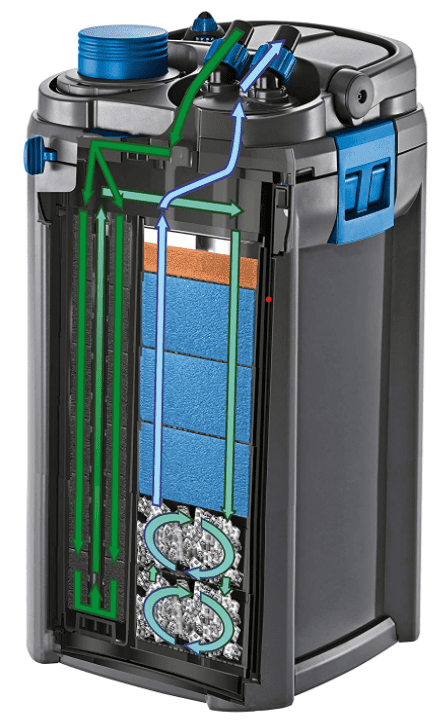
- Prefilter – Almost all of the external filters now a days comes with a prefilter which is a coarse sponge which can trap large particles.
- Biological filter media – which has lot of surface area or pores on which biological bacteria lives on so larger the surface area it is better for the aquarium.
- Fine Filter mesh – These are fine sponges which helps in removing smaller particles and polishing the water.
- Carbon – Activate carbon is also used in one of the trays if you want to remove execess nutrients or any harmful chemicals if it is present in your source water. Only use it for a short term in your filters if you are having a planted tank as they will remove the nutrients or fertilizers from the water column and your plants will be devoid of nutrients to grow.
Recommended Filter media or other essentials for filters
- Seachem Purigen – Once of the good filter media is to have Purigen as it purifies or cleans the water and remove any tint in the water. For e.g. if you are using a new drift wood it might release some tanins in the water.
- Seachem Matrix – One of the best biological media out in the market, which has a large surface area, helps to convert ammonia to nitrate.
- Ada Bio Rio – It is another biological filter media which is recommended for filters but the only drawback is that it is small in size so you need a good filter pump otherwise your filter will get clogged very easily.
- Eheim Substrate Pro – It is another biological media which is very good and works really well in the long run.
- Seachem stability is very good a new tank and helps establishing and jump starting your tank with good bacteria.
- Seachem Prime – Removes Chlorine, Chloramine, Detoxifies ammonia, nitrite, and nitrate
Types of Aquarium Filters
Sponge Filter

Sponge filters are mainly used only for smaller tanks or for breeding setups, they don’t help much in filtration especially biological filtration since sponges don’t have a lot of surface area to live on.
If you sponge filter comes with two chambers one with biological media and another with coarse sponge they will work well for a small tank as they will some level of biological filtration.
If you are using sponge filter then your tank will need regular maintenance as there are high chances of ammonia spikes since biological filtration doesn’t happen properly.
Hang on the back filter
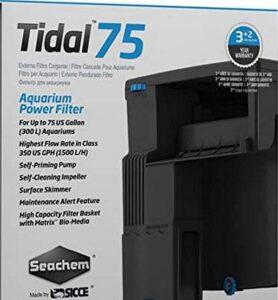
Hang on the back filters are generally used for nano tanks or medium size tank and not recommended for large tanks (20-to-30-gallon tank). They have both sponge and biological media but since filter media is present in small quantity it is only good for small tanks.
Sump filter
Sump filters are used for large aquarium like more 100 liters when you need large volumes of water for fishes. This will help to stabilize the tank parameters but I really don’t like sump filters and I don’t recommend them.
External Canister Filter
External Canister Filters are the best filters available for your tank. It carries lot of volume of biological media and mechanical media. The more the volume of biological media it is better for your tank as it will keep the tank parameters and will not allow any spike in ammonia levels.
Most of the brands of canister filters comes with 3 trays or 4 trays of media. Ensure that only tray is set for mechanical filtration like sponges and the remaining trays you are packing them with good quality biological media which I have recommended earlier in the article.
Always ensure that filter is get below the tank level so that water can flow through gravity and filtration takes properly.
Some of my recommendation for good quality filters are given below
Oase canister filter
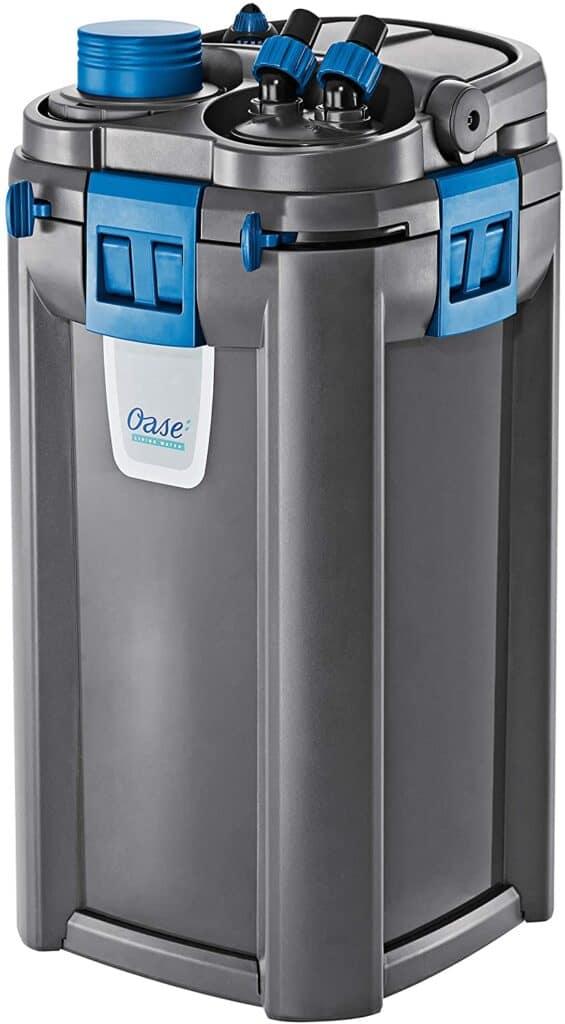
Oase is one of the leading brands in aquarium space and they have a good number of filter series, the bio master series is the recommended one.
What makes standout from the rest is the way the filter is setup. It has a prefilter which can be removed without opening the entire filter. Which comes quite handy in maintenance of the filter.
It is usually prefilter which captures the bigger debris and needs regular maintenance so you don’t need open the full filter. It comes in various sizes and flow rates depending on your requirement.
You can just keep one media tray with sponges and remaining trays can be used for biological media.
If you need more details on the filter series please Oase website
https://www.oase.com/en/products-a-z/family/f/biomaster.1000927305.html
Eheim canister filter
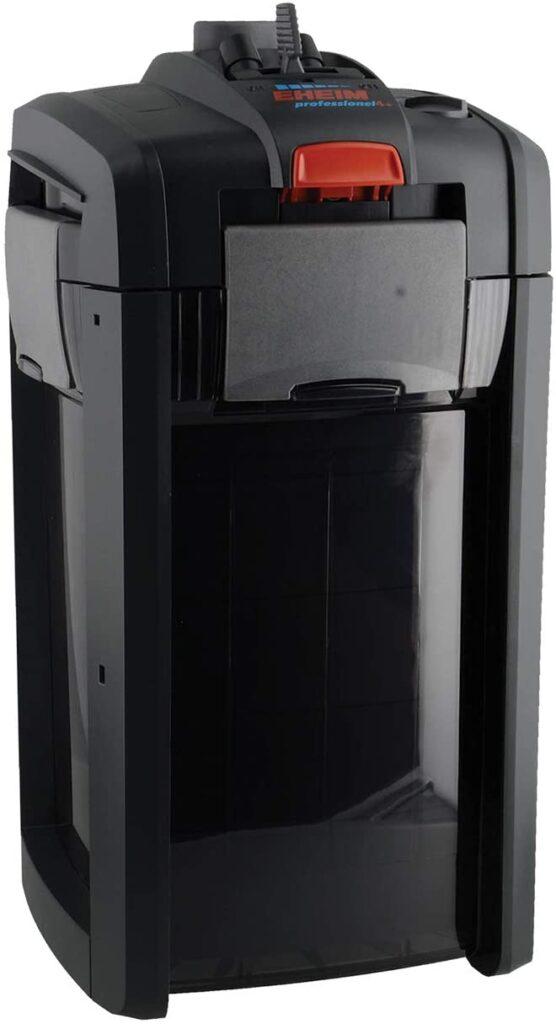
Eheim is one of the oldest brands in the aquarium space and they are more than 70 year old company and they are one of the best filter brands around. They are famous not only for filters but for other accessories like Heaters, internal filters, UV light, Biological media and Skimmers.
The traditional classic series 2217, 2211, 2213, 2215 are good for medium size aquariums and the professional series, Pro 3+ or Pro4+ are good for large size aquariums.
These filters are very reliable and they run for many years and it is also easy to find parts for these filters.
https://eheim.com/en_GB/aquatics/technology/external-filters/?p=1
Fluval canister filter
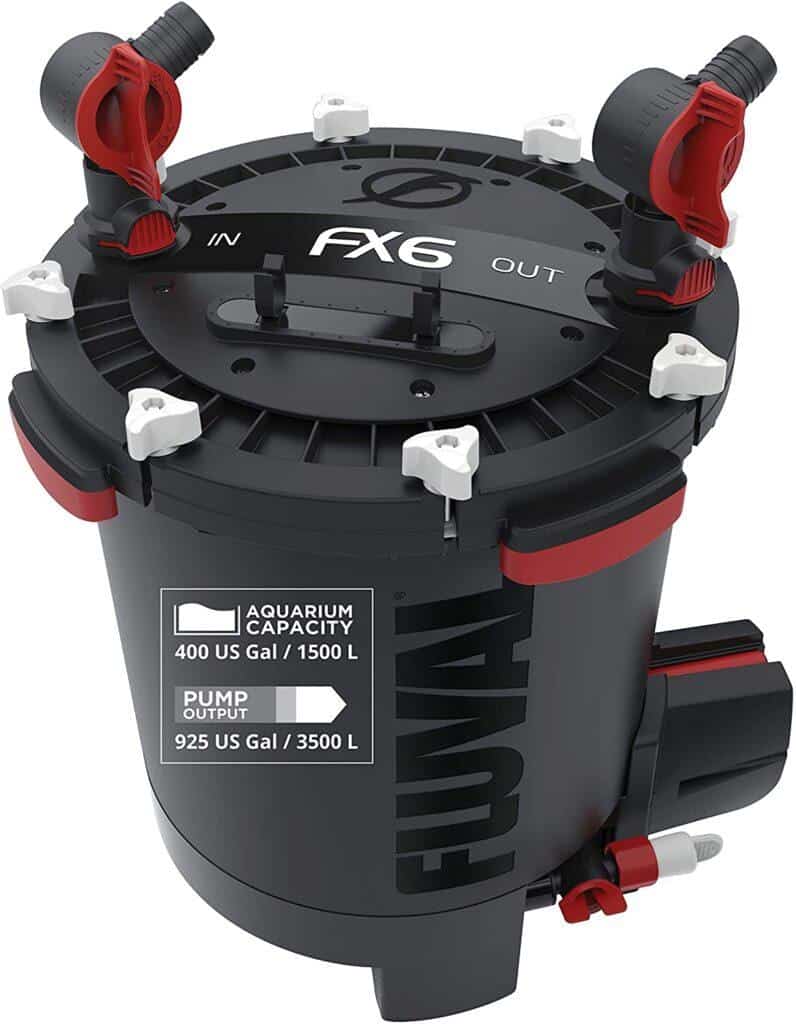
Fluval is another brand which is reliable and comes with lot of products in the aquarium space. They are quite sturdy and provides good quality of flow in your tank.
Fluval 6 and 7 Series is good for medium size tanks and FX series is the professional series which is good for large aquariums with good flow rate.
Fluval Filtration & Media – External Filtration systems (fluvalaquatics.com)
Sunsun canister filter
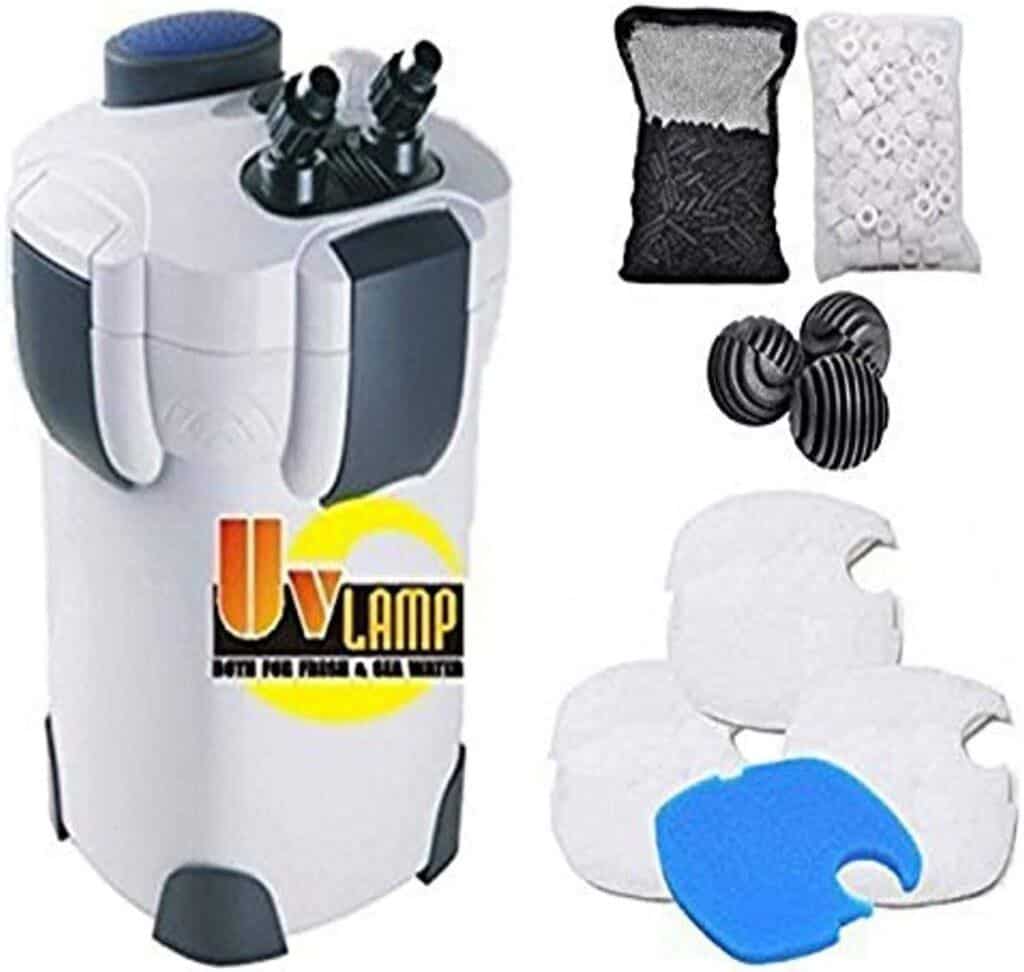
If you are looking a cheaper option compared to the earlier options or if you are a beginner and you don’t want to invest on an expensive filter then you can go for the Sunsun canister filters, they do perform well and run for a long time. The only problem I have seen is that the build quality is not so good compared to others I have mentioned here.
They are a good brand and they produce lot of equipment’s in the aquarium space so if you are starting in the fish keeping hobby it is definitely worth buying a Sunsun canister filter. It might be known by a different name in your country as sometimes they are repackaged under a different name.
Aquarium Filters Manufacturers, China Aquarium Filters Suppliers (sunsun-china.com)
Tips for Maintaining Your Aquarium Filter
The filter is one of the most important parts of your aquarium. It is responsible for removing ammonia, nitrates, and other pollutants from the tank water.
There are many ways to maintain your filter and keep it running at its best. The first thing you should do is to change the filter cartridge every month. This will help remove any build-up of bacteria and toxins that may have accumulated on the inside of the filter. The next thing you should do is to clean out your gravel once a month or so. This will prevent any build-up or debris that may be clogging up the pores in your gravel and slowing down water flow through it. Finally, you can use a siphon to clean out any debris that has settled on the bottom of your tank or under plants or decorations in your tank.
Ensure that your filter is running 24*7 since if it is not turned on full time then you will beneficial bacteria present in your filters biological media will die. Usually, bacteria starts dying after 2 to 3 hours due to lack of oxygen.
If there is any power outage in your area and if its take a longer time for your power to return then turn off the power supply to your canister filter, open the canister, ensure that the media is sitting below the water level this will prevent the bacteria from dying off.
Whenever you are doing maintenance to your canister filter ensure that you are cleaning filter head which houses the pump and impeller which is housed inside of it. Take the impeller and clean it gently. Please note that impeller is made of ceramic so be careful in cleaning it as it might break if you put excess pressure on it.
All the biological media should be cleaned in aquarium tank water and not in tap water. If you clean the media in tap media all the good bacteria will be dead and tank cycling has to been from start.
The prefilter like coarse sponges can been cleaned in tap water and also change the fine filter pads regularly during canister maintenance as they get easily clogged with fine debris.
Use Vaseline petroleum jelly for the O ring or gasket between filter head and body of the aquarium, this ensures that filter is sealed air tight and there is no water leakage. If you don’t use Vaseline then in course of time due to salt deposits from water harness it will be not water tight and it will start leaking.
Conclusion
Aquarium filters are a necessary component to maintain a healthy fish tank. They keep the water clean and it can be tricky to choose the right filter for your tank.
There are three main types of aquarium filters: Canister, Hang-on, and Sponge. Each one is best suited for different tanks and has their own pros and cons.
Choosing the right filter for your tank is not easy but with this guide, you will know what type of aquarium filter you need.
FAQs
What is the purpose of an aquarium filter?
Aquarium filters are crucial for maintaining water quality and clarity by removing physical debris, chemical pollutants, and biological waste, ensuring a healthy environment for aquatic life.
How do aquarium filters work?
Aquarium filters work by passing water through media layers to mechanically, chemically, and biologically cleanse it from contaminants, thus mimicking the natural filtration processes found in aquatic ecosystems.
What are the types of aquarium filters available?
The main types of aquarium filters include canister filters, hang-on-back (HOB) filters, sponge filters, undergravel filters, and internal filters, each serving different aquarium sizes and needs.
How often should I clean my aquarium filter?
Cleaning frequency varies by filter type and tank bioload, but generally, it’s recommended to clean your aquarium filter every 2 to 4 weeks to ensure optimal performance and water quality.
Can an aquarium filter be too powerful for my tank?
Yes, an overly powerful filter can create strong water currents that are stressful for fish, especially for species that prefer calm waters. It’s important to choose a filter with an appropriate flow rate for your aquarium size and inhabitants.
What is the best aquarium filter for a beginner?
For beginners, hang-on-back (HOB) filters or sponge filters are often recommended due to their ease of use, installation, and maintenance, making them suitable for small to medium-sized tanks.
How do I set up an aquarium filter?
Setting up an aquarium filter involves assembling the filter according to the manufacturer’s instructions, placing it in the correct position in or on your aquarium, and ensuring it’s properly primed with water before turning it on.
What is biological filtration and why is it important?
Biological filtration is the process of beneficial bacteria breaking down toxic ammonia and nitrites into less harmful nitrates. It’s crucial for maintaining a healthy and stable environment for aquarium inhabitants.
How do I choose the right size filter for my aquarium?
To choose the right size filter, consider the filter’s flow rate, which should typically circulate the aquarium’s water volume at least 4 times per hour. Account for the tank size, bioload, and specific needs of your aquatic life.
Can I use multiple filters in my aquarium?
Yes, using multiple filters can provide better filtration, especially in larger tanks or those with higher bioloads, and offers redundancy to keep the filtration system running if one filter fails.
How do I know if my aquarium filter is working properly?
Signs of a properly working aquarium filter include clear water, no unusual noises, and a consistent flow rate. Regularly check for any blockages or mechanical issues.
What maintenance does an aquarium filter require?
Regular maintenance includes cleaning or replacing media, checking for clogs, ensuring the impeller is running smoothly, and occasionally deep cleaning the entire unit to prevent buildup of detritus and maintain efficiency.
Can I turn off my aquarium filter at night?
Turning off your aquarium filter at night is not recommended as it disrupts the filtration process, potentially harming water quality and the health of your aquarium inhabitants.
What is the difference between mechanical, chemical, and biological filtration?
Mechanical filtration removes physical debris, chemical filtration uses activated carbon or similar materials to remove toxins, and biological filtration converts harmful ammonia and nitrites into safer nitrates through beneficial bacteria.
Do I need a special filter for a saltwater aquarium?
Saltwater aquariums often require more powerful and specific types of filtration, such as protein skimmers in addition to traditional filters, to handle the unique waste and bioload challenges of marine environments.
How can I reduce noise from my aquarium filter?
To reduce noise, ensure the filter is properly installed, the water level is adequate to prevent splashing, and all parts are clean and functioning correctly. Sometimes, using a pre-filter or adjusting the flow rate can also help.
What should I do if my aquarium filter stops working?
If your filter stops working, check for electrical issues, ensure it’s properly assembled, clean any clogged parts, and inspect the impeller for damage. If problems persist, consult the manufacturer’s guide or consider replacement.
Can I clean filter media with tap water?
Cleaning filter media with tap water can kill beneficial bacteria due to chlorine and other chemicals. It’s best to use tank water or dechlorinated water to preserve the biological filtration.
How do I cycle my tank with a new aquarium filter?
To cycle a tank, set up the aquarium and filter, then follow a fishless cycle by adding ammonia sources and monitoring water parameters until beneficial bacteria establish, usually taking 4-6 weeks.
What are the signs of a clogged aquarium filter?
Signs of a clogged aquarium filter include reduced flow rate, increased noise, and visible accumulation of debris on the filter intake or within the filter itself, indicating it’s time for maintenance.
If you have any doubts or if you want me to add any extra details, please do get in touch with me.
co*****@*******************le.com
Thanks.
I am a passionate aquarist with over 30 years of hands-on experience in fishkeeping. My journey began at a young age, collecting fish from the wild and learning through experimentation. Specializing in tropical fish, I bring a deep understanding of the hobby to FishKeepingMadeSimple. The site provides honest, detailed reviews of essential products and accessories to help fellow enthusiasts create the best environments for their fish.

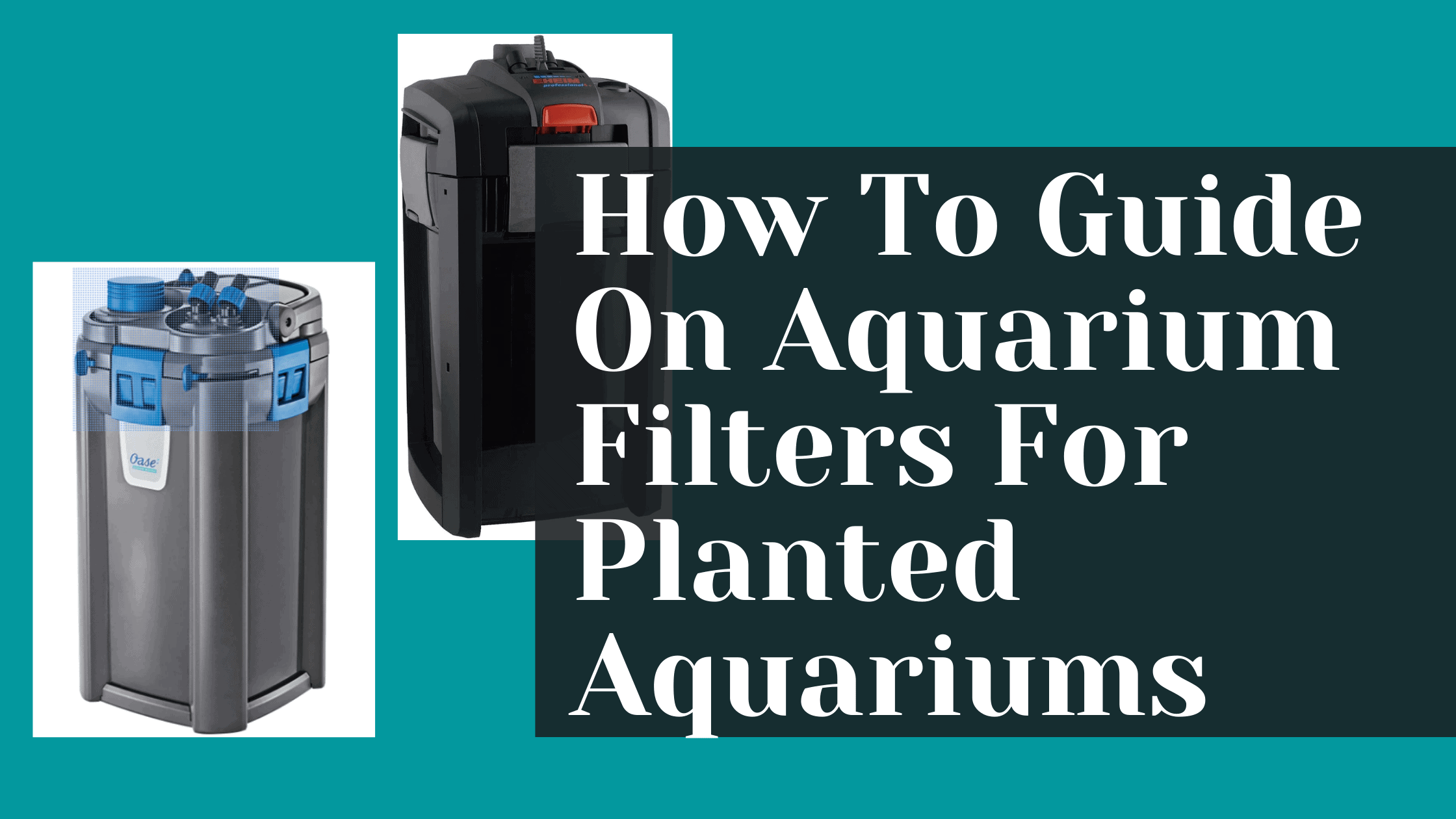








[…] A densely planted tank with live plants provides hiding spots and creates a natural environment for glass […]
[…] aquarium filter keeps the water clean in the hospital tank. A sponge filter is good because it cleans gently, not bothering the […]
[…] Platy fish (Xiphophorus maculatus) are very popular. They are known for their bright colors. This makes them a great choice for fish tanks. […]
[…] Aquascaping is key to making a calm home for electric blue rams and other fish friends. It uses natural barriers to cut down on fights in the fish tank. […]
[…] Flowerhorn cichlids are territorial and like being in pairs. They choose their space in the tank. This can include caves and rocky areas. They are lively during the day. These fish add energy and color to any fish tank. […]
[…] fish are a favorite in the fish tank world, thanks to their bright blue hues and special looks. The German-bred kinds are especially […]
[…] stand out with their shiny gold and black colors. They add beauty to any fish tank. These fish, known as Platypoecilus, get along well with Bolivian Rams. They match in size and […]
[…] conclusion, Java Moss is a great choice for beginner aquarium plants. It’s easy to care for and can grow in many conditions. It also provides a natural look and […]
[…] plants are more than just pretty in your fish tank. They are key for keeping fish safe and healthy. By watching the plants and keeping conditions […]
[…] are many shrimp tank filters to choose from, each with its own benefits and drawbacks. Sponge filters for shrimp are loved for being cheap, easy to care for, and soft on the shrimp. Hang-on-back […]
[…] the water clean is vital for the shrimp’s health. Use an air-driven sponge filter or an undergravel filter. These filters are safe for baby shrimp and keep the water […]